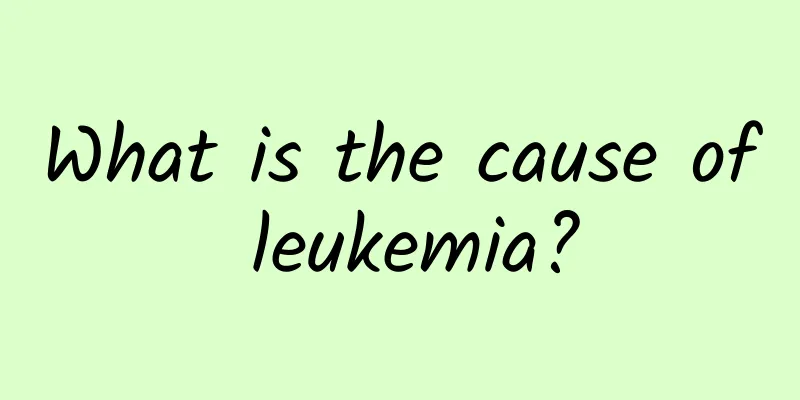What is the cause of leukemia?

|
Leukemia patients must pay attention to actively cooperate with the doctor's treatment. At the same time, we should pay more attention to learning more about the causes of leukemia in our lives. Common ones include viral infections or genetic factors, as well as some radioactive factors that can induce leukemia. 1. Viruses It has long been confirmed that type C RNA tumor viruses, or retroviruses, are the cause of spontaneous leukemia in mammals such as mice, cats, cattle, sheep, and primates. This virus can synthesize a DNA copy, namely a provirus, according to the RNA sequence through endogenous reverse transcriptase, which can induce malignant transformation when inserted into the host's chromosomal DNA. Tumor viruses carry viral oncogenes (v-onc). Most vertebrates (including human cells) have genes homologous to v-onc in their genomes, called oncogenes. After v-onc is integrated into the genome of the host cell, it can cause adjacent genes to undergo malignant transformation. Retroviral infection can also activate tumorigenic genes, turning them into malignant transformation genes, leading to malignant transformation of target cells. Even if the viral genes that enter the body do not contain v-onc, they may cause leukemia if they change the normal function of the genes. The study of viral etiology of human leukemia has a history of several decades, but so far only adult T-cell leukemia has been confirmed to be caused by viruses. 2. Genetic factors Genetic factors are associated with the development of some leukemias. 8.1% of leukemia patients had a family history of leukemia, while only 0.5% of the control group had a family history of leukemia. The incidence of acute lymphoblastic leukemia in people who marry close relatives is 30 times higher than the expected value. Certain genetic diseases with chromosomal abnormalities and breaks are often accompanied by a higher incidence of leukemia, such as Down syndrome, congenital vascular dilatation erythema (Bloom syndrome) and Fanconi anemia. 50% of children with acute lymphoblastic leukemia have a special palm print called Sydney line. There is a certain connection between leukemia and HLA antigen types. For example, acute lymphoblastic leukemia is often accompanied by HLA-A2 and A9. All of these indicate that there is some connection between genetic factors and the onset of leukemia, but for most leukemias, leukemia is not a hereditary disease after all. 3. Radiation factors: Ionizing radiation can cause leukemia, and its effect is related to the radiation dose and the radiation site. A single larger dose (1-9 Gy) or multiple smaller doses can cause leukemogenesis. Whole-body irradiation and radiation field irradiation, especially bone marrow irradiation, can lead to myelotoxicity and immune-toxicity. Chromosome breakage and recombination can still be observed several months after irradiation. Radiation can cause reversible breaks in double-stranded DNA, allowing tumor-causing viruses in cells to replicate and be excreted. Radiation can induce acute and chronic non-lymphocytic leukemia and chronic myeloid leukemia, but not chronic lymphocytic leukemia. There is often a period of bone marrow suppression before the onset of the disease, and its latent period is about 2 to 16 years. 4. Chemical factors The leukemogenic effect of benzene is relatively certain. Benzene-induced acute leukemias are mainly acute myeloid leukemia and erythroleukemia. It is also certain that alkylating agents and cytotoxic drugs can cause secondary leukemia. Most secondary leukemias occur after long-term treatment with alkylating agents for existing lymphatic system malignancies and malignant tumors that are prone to immunodeficiency. Secondary leukemia is also prone to occur after chemotherapy for breast cancer, ovarian cancer, and lung cancer. |
<<: What are the symptoms of leukemia?
>>: What is the difference between melanoma and mole?
Recommend
What causes dermatitis?
Dermatitis is a very common skin disease in life....
The effect of soaking Ophiopogon japonicus and lotus seeds in water
Ophiopogon japonicus and lotus seeds are both tra...
Tuberculous pleurisy treated with traditional Chinese medicine, these 4 prescriptions are very effective
Tuberculous pleurisy is a very harmful disease, s...
External application prescription for lumbar disc herniation
Using some plasters to treat lumbar disc herniati...
What is the Cold School of Traditional Chinese Medicine?
Traditional Chinese Medicine is the most traditio...
Why does urine smell fishy?
Some people's urine always has a fishy smell,...
Is Chinese medicine or Western medicine better for treating depression?
I believe that everyone has more or less known ab...
These recipes can help you easily relieve the headache of washing your hair
Headache is a very common condition in daily life...
What should I do if my herpes simplex virus antibody is positive?
Under the slogan of eugenics, many friends will m...
Peripheral neuritis
Peripheral neuritis is a disease that causes numb...
How is the ovulation period calculated?
Understanding the ovulation period is not only to...
What is the normal range for pulse after exercise? Normal pulse range
Pulse is the rhythm of our heart beating and bloo...
What are the effects and functions of mother of pearl?
In traditional Chinese medicine, many Chinese med...
The pros and cons of cupping during menstruation
It is best not to cupping during menstruation, be...
Myrtle wine effects and functions
The main ingredient of myrtle wine is myrtle, whi...









